
The Northern Renaissance Part 2:
The Politics of Paint
The Northern Renaissance Part 2:
The Politics of Paint
Released: Spring 2022
6 part series
This is a series about Art, Politics, and Power. Following on from Northern Renaissance Part One: A Window Onto the World, we’ll move into the 16th century via the artists of Germany, France, Scotland, and England – Dürer, Cranach, and Holbein to name a few.
As the shape of patronage changed, we’ll see how art was bound in the politics of the Protestant Reformation, England’s break from Rome, Henry VIII’s tally of wives, Elizabeth I’s thrilling power struggle, and her fight against Spain – this is one of the most fertile and fascinating periods in Northern European history.
Art – as ever – is the most potent and relatable illustration of these extraordinary times.
Buy Individual Lectures from the Series:
-
Dürer was a game-changer for the Northern Renaissance. He was the most skilled engraver Europe had ever seen and had a better understanding of the power of self-promotion than any previous European artist. His fierce intellect sits him alongside the greatest philosophers of the time. A legend in the world of art history, he rocked the late 15th and early 16th-century art world to its core. In this talk, we’ll be looking at his astonishing etchings as well as those famous self-portraits.
-
Through Cranach’s fascinating art, we see him teetering on the divide between Catholicism and the emerging Lutheran religious traditions. This was a time of Reformation. Of war. Deeply unsettling yet astonishingly fertile. Cranach, working for the Electors of Saxony, got stuck into it all. Thrilling mythological and biblical narratives poured out of his workshop as well as some of the best portraits of the period. Cranach’s unique and strange artistic style is a highlight of all Northern Renaissance art.
-
The Tudor Court of Henry VIII is one of the most dramatic periods of English history. And because of the stunning paintings of Hans Holbein the Younger, we can have an ever-more intimate insight. Holbein’s role within the English Tudor court was instrumental. Not only did he throw England’s lacklustre art scene into international prominence by creating a completely modern style of portraiture, but today he provides us with the key to understanding the priorities of one of the most complex monarchs of all British history: the large, terrifying and fickle presence of Henry VIII.
-
The story of the French Renaissance is a fascinating, yet often overlooked, tale. At its heart sits François I, a Renaissance prince through and through, with the desire, means and commitment to bring France into the modern age of art. Furthermore, like the other leaders of the day, he fully understood art to be a political weapon par excellence. The astonishingly bold and grand Fontainbleau is the site of his greatest cultural ambitions and the first part of our talk will centre around this project.
Inspired by her father-in-law, and the blood of her family coursing through her veins, Catherine de Medici picks up François’ baton and takes the art of the French royal family in a completely new direction. This time, reflecting new tastes across Europe and rivalling the patronage of Elizabeth I in England, Catherine de Medici worked closely with portrait painters – in particular François Clouet, one of the most talented artists of the day.
-
In the Musée de Cluny, you walk into a very special darkened room. As you do, you enter the magical world of the Lady and the Unicorn. So much mystery, so much romance. So much detail, and colour. How have these tapestries survived so well, you think, as you fall into the tantalising symbolism of these immense pieces of art. It is no surprise these enigmatic works have inspired best-selling novels. Join Rose for a special talk to explore their secrets, symbolism, and bewitching story.
-
If you ever need help with your LinkedIn profile, look to portraits of Elizabeth I. The most culturally canny English monarch to date, this phenomenal Queen saw the arts almost as an arm of government. Miniatures and oils, love tokens and messages of war, we find the full picture of Elizabeth through these power portraits.






